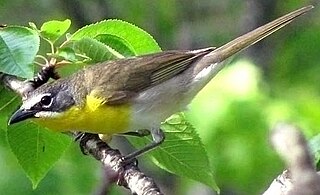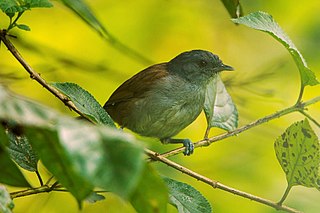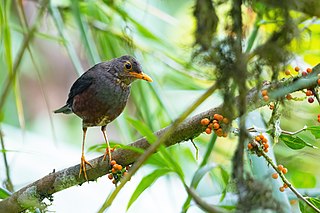
Wilhelm Peter Eduard Simon Rüppell, also spelled Rueppell was a German naturalist and explorer, best known for his collections and descriptions of plants and animals from Africa and Arabia.

The yellow-breasted chat is a large songbird found in America, and is the only member of the family Icteriidae. It was once a member of the New World warbler family Parulidae, but in 2017, the American Ornithological Society moved it to its own family. Its placement is not definitively resolved.

The Tasman Sea island thrush is an extinct forest bird in the thrush family that was formerly found on Lord Howe Island and Norfolk Island in the Pacific Ocean. It is part of the "island thrush" complex that has been split into 17 species based on a molecular phylogenetic study published in 2023. The two subspecies of the Tasman Sea island thrush became extinct in historical times.

The moorland chat, also known as the alpine chat or hill chat, is a species of songbird in the Old World flycatcher family. It is endemic to north-east Africa where it is common in its habitat. It lives at high altitudes on moors and grassland, usually above 3,400 m (11,100 ft), but can live as low as 2,100 m (6,900 ft). It has a short tail and long legs. It is bold and will approach people.

Erckel's spurfowl, also known as Erckel's francolin, is a species of game bird in the family Phasianidae.

Turdoides is a genus of passerine birds in the laughingthrush family Leiothrichidae. The species are distributed across Africa and southern Asia and are typically fairly large, long-tailed birds which forage in noisy groups. The majority of species have drab brown or grey-brown plumage. Several species that were included in Turdoides in the past have been reassigned to Argya following a 2018 study that found multiple clades.

The white-throated greenbul or white-throated bulbul, is a species of passerine bird in the bulbul family, Pycnonotidae. It is widespread across the African tropical rainforest. It was formerly considered to be conspecific with the Angola greenbul.

The groundscraper thrush is a passerine bird of southern and eastern Africa belonging to the thrush family, Turdidae. It was previously considered the only member of the genus Psophocichla, but phylogenetic analysis supports it belonging in the genus Turdus, of which it is the most basal species.

The pale thrush is a passerine bird of the eastern Palearctic belonging to the genus Turdus in the thrush family Turdidae. It is closely related to the eye-browed thrush and grey-backed thrush.

The Ethiopian oriole is a species of bird in the family Oriolidae.

The African hill babbler is a species of bird in the family Sylviidae.

The white-throated thrush is a species of bird in the family Turdidae. It is found in Mexico and Central America, ranging south to central Panama. This species has been referred to in some literature as "white-throated robin." However, that name is now more usually applied to the Old World species Irania gutturalis.

The red-legged thrush is a species of bird in the family Turdidae. Native to the Caribbean, it is found in the Bahamas, Cayman Islands, Cuba, Dominica, Hispaniola and Puerto Rico. It formerly occurred on the Swan Islands, Honduras, but was extirpated there.

The Ethiopian white-eye, formerly known as Heuglin's white-eye or montane white-eye, is a small passerine bird in the white-eye family Zosteropidae. It is found in southeast Sudan, Eritrea and north, central and east Ethiopia. Its natural habitats range from subtropical or tropical moist montane forests, to subtropical or tropical high-altitude shrubland, plantations, and rural gardens.

The Tibetan blackbird is a species of bird in the thrush family Turdidae. It is found in the Himalayas from northern Pakistan to southeastern Tibet. Originally described as a separate species by Henry Seebohm in 1881, it was then considered a subspecies of the common blackbird until 2008, when phylogenetic evidence revealed that it was only distantly related to the latter species. It is a relatively large thrush, having an overall length of 23–28 centimetres. Males are blackish-brown all over with darker plumage on the head, breast, wings and tail and dull orange-yellow bills, while females have browner underparts, faint streaking on the throat, and a dull darkish yellow bill. Both sexes may seem slightly hooded. It can be differentiated from the common blackbird by its complete lack of an eye-ring and reduced song.

The rufous-collared thrush is a species of bird in the family Turdidae.
The African red-rumped swallow is small passerine bird in the swallow family Hirundinidae. It is found in northern areas of Africa south of the Sahara.

The Pantepui thrush is a bird in the genus Turdus native to the tepuis of northern South America. It was previously considered conspecific with the black-billed thrush, but genetic data indicates that the two are not closely related.

Fiji island-thrush is a species of passerine in the thrush family Turdidae that is endemic to Fiji. It was formerly considered a subspecies of island thrush, but in 2024 the island thrush was split into 17 separate species by the IOC and Clements Checklist based on morphological and phylogenetics differences.
The Moluccan island thrush, also known as the Sula island thrush, is a species of passerine bird in the thrush family Turdidae. It is endemic to Indonesia. Prior to 2024 it was considered to be two separate subspecies of the island thrush.



















